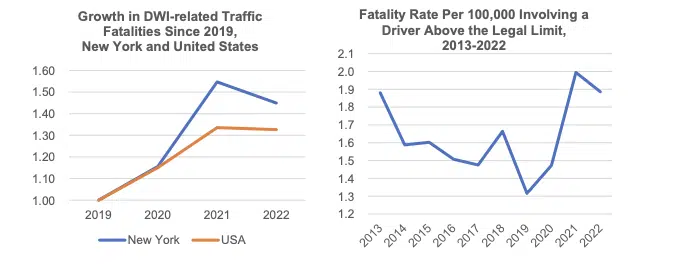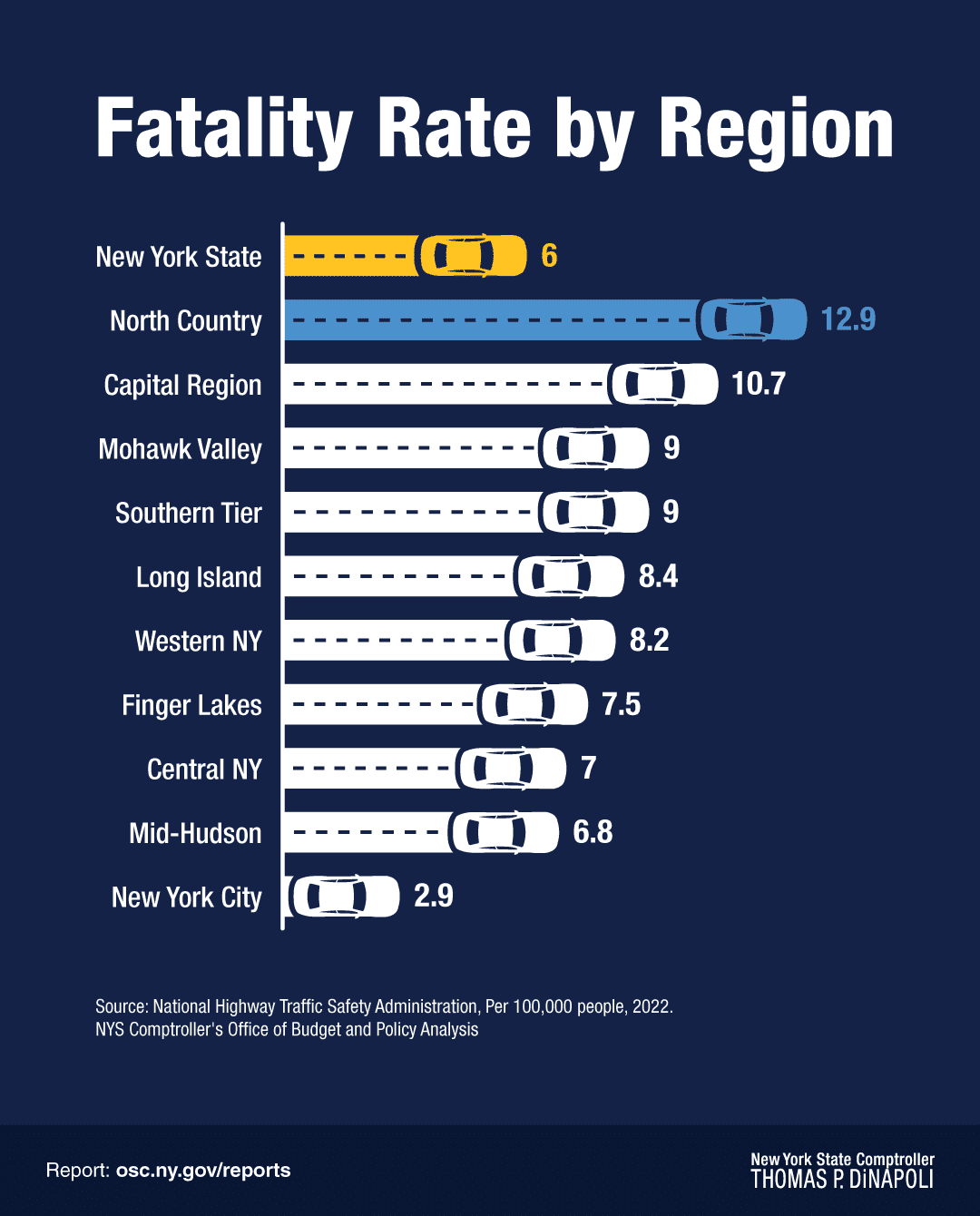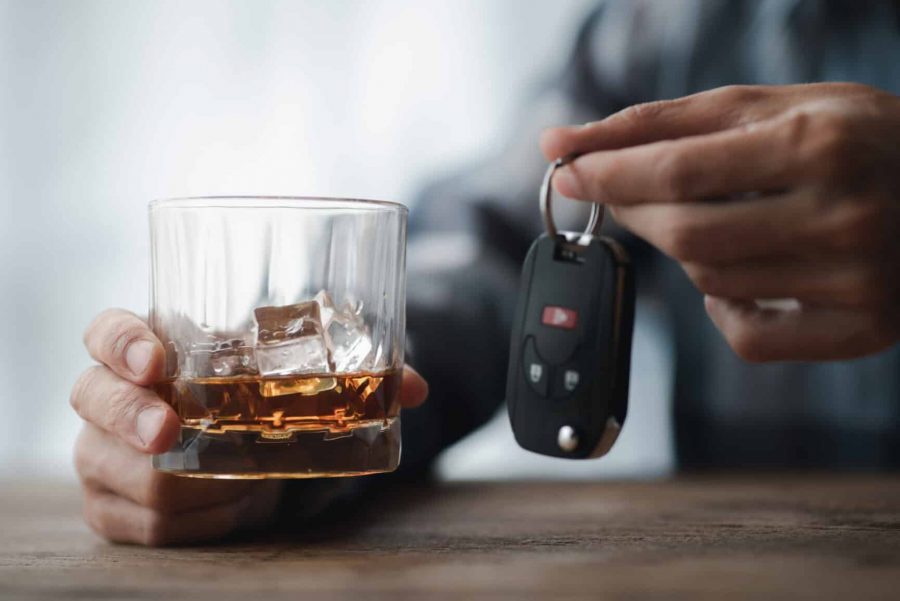A drunk driving crash kills someone in the United States every 39 minutes. There were 13,524 deaths from drunk-driving crashes in 2022. Our backyard, Buffalo, NY, has 2.17 fatal DUI crashes per 100,000 people.
Since the pandemic, more fatal car accidents have occurred across New York, particularly involving drunk drivers. There was a 45 percent increase in fatalities involving drunk drivers from 2019 through 2022, and one in three crashes involved a driver with a blood alcohol content above the .08 DWI legal limit.
You may be feeling overwhelmed, frustrated, or scared after a crash. We understand the physical, financial, and emotional impacts of drunk driving accidents, and our award-winning team is here to assist you.
Here are some steps you can take after getting in an accident with a drunk driver to protect your rights, stay safe, and begin recovering. For fully personalized, experienced legal guidance, contact us today.

- Step 1: Contact Emergency Services and Focus on Immediate Safety
- Step 2: Medical Assessment and Treatment
- Step 3: Key Accident Documentation and Evidence
- Step 4: Drunk Driving Accident Case Liability and Value
- Step 5: The Benefits of Hiring a Lawyer
- FAQs After a Drunk Driving Accident
- Richmond Vona Is Here For You After a Drunk Driving Accident

Step 1: Contact Emergency Services and Focus on Immediate Safety
The health and safety of yourself and others on the road dictate the initial steps to take after a car accident. If you smell gasoline or there is a fire, exit the vehicle immediately before taking further action.
Contacting Emergency Services
Call 911. Police officers can direct others around your crash while firefighters and EMTs work to extract and treat the injured. Try to stay calm to make it easier to communicate with emergency responders. If 911 isn’t unavailable, ask a passerby or nearby business for help.
Give the dispatcher essential details such as your name, accident location, landmarks, or GPS coordinates. Provide a detailed description of the vehicles involved and whether a driver left the scene. Describe injuries as best you can.
Listen to the dispatcher carefully and answer all their questions. Timely and clear communication is essential to helping first responders prepare and may expedite their response.
Safety Assessment
Check your and your passengers’ injuries. Use pressure to stop bleeding, but do not move a passenger unless there is leaking gas or a fire. If you cannot move, honk or wave for help. Before leaving your vehicle, check carefully for traffic and avoid twisted metal and other hazards.
If it is safe, move off the road and a safe distance from the crash site. Don’t interact with the drivers or passengers of other vehicles if they appear intoxicated or hostile. Traffic accidents are unnerving, and your adrenaline may be flowing. Stay calm and focused to avoid additional risks from your crash.
Scene Protection While Waiting for Help
Turn on your hazards to alert other drivers. Place warning devices such as flares, cones, or reflectors 50 feet from your vehicle in urban areas and 100 feet away on highways. Make adjustments for weather, road, and nighttime conditions. For example, if the roads are slick or your accident is around a curve, give other drivers more notice.
When it is safe to do so, take photos and video of the vehicles, damages, skid marks, and road conditions. Collecting this evidence is important, but your primary goal while waiting for help is to prevent further accidents by making your crash clearly visible.
You don’t have to follow the steps to take after getting in a car accident with a drunk driver to the letter. No matter the circumstances, our team of drunk driving accident lawyers is here to guide and support you.
Step 2: Medical Assessment and Treatment
If you don’t leave your accident scene in an ambulance, you still need medical attention. It could be hours or days before you feel the full effects of your crash.
Immediate Medical Care
Even if you feel fine, seek medical attention immediately. Injuries such as whiplash, brain trauma, or internal bleeding can take hours or days to show delayed onset symptoms. A qualified medical professional can catch these injuries during testing.
Symptoms of injuries that are sometimes not immediately apparent include the following:
- Headaches or dizziness due to a possible concussion or other brain injury
- Neck pain from whiplash, often related to getting rear-ended by a drunk driver
- Abdominal pain caused by internal injuries
- Inflammation from soft tissue damage
- Increased localized pain from a fracture
Even if you did not go to the hospital or urgent care after the accident, we can still assist you. If necessary, we will find you qualified medical professionals and viable transportation options, such as ambulances or assistive transportation services. Even if they find no new injuries, you may benefit from pain management after an accident.
Medical Documentation
Organizing your medical records is critical to preserving evidence for an insurance claim or a lawsuit. Create a clear filing system, categorizing important correspondence, including:
- Doctor’s notes
- Test results
- Billing statements
- Medical travel-related expenses
Ask for written summaries after every appointment that link your visit to your accident. Keep a symptoms and pain journal that details the effects of your crash. Bring your medical documentation and journal to your initial legal consultation.
Step 3: Key Accident Documentation and Evidence
To be successful in an insurance claim or lawsuit, you need evidence of the other driver’s intoxication and from the accident scene. If it’s safe, make observations and bolster your drunk driving accident claim by communicating that information to the insurance company or at trial.
Observing and Documenting Intoxication Evidence
Document signs of intoxication only when it’s safe and appropriate, and write down details you observe to share with the police. The signs fall into the following three categories:
Visual Signs
- Red or bloodshot eyes, slurred speech, unsteady movements, and delayed reactions
- Vehicle damage, such as dents and scratches
Behavioral Signs
- Erratic speech, aggression, or being overly friendly
- Confusion or difficulty following instructions
Environmental Evidence
- Open alcohol containers
- Alcohol odor
Essential Accident Documentation
Getting documentation from law enforcement is one of the essential steps to take after an accident with a drunk driver. Police reports provide details that typically include:
- Driver information: Name, license number, contact information, and proof of insurance details
- Vehicle information: Makes, models, colors, license plate numbers, and registration details
- Witness information: Names, contact information, and brief statements
- Incident details: Date, time, and location of the accident, and in some cases, weather or other details
- Officer observations: Driver behavior, physical signs of intoxication, and vehicle descriptions
You can get copies of police reports from the Department of Motor Vehicles or police websites such as the New York State Police or Erie County Sheriff’s Office. Your attorney can assist you in obtaining accident reports, determine if any information is missing, and assist you in gathering it.
Do not discuss fault when sharing information with the other driver or the police—stick to factual exchanges.
Step 4: Drunk Driving Accident Case Liability and Value
Under New York’s pure comparative negligence law, you must establish that the other party was at least partly liable for your crash to collect damages. How fault is apportioned determines what you are entitled to after a drunk driver hits you.
Establishing Liability
You must present evidence showing the other driver caused or contributed to your crash. Key sources of evidence include the following:
- Police reports
- BAC level or field sobriety test results
- Video footage or photos
- Eyewitness statements attesting to impaired driving behaviors
- Detailed professional accident reconstructions
Partner with our experienced Buffalo drunk driving accident lawyers so we can help gather and interpret the evidence of the other driver’s liability. If the driver was working at the time, our knowledgeable attorneys can prepare a spoliation letter demanding their employer preserve evidence such as driving logs.
Step 5: The Benefits of Hiring a Lawyer
You don’t have to hire an attorney after a drunk driving accident, but it could be a mistake not to. Few accident claims are straightforward, and an experienced attorney can help with more than your accident claim.
Ongoing Medical Care
Consistent medical care aids in your recovery and strengthens a legal or insurance claim. You need a consistent, documented care record to bolster your case. Record everything in your recovery journal to document your symptoms, pain levels, and improvements over time, and share it with your attorney.
A great legal team like ours can assist you in finding ongoing medical care, connect you with trusted providers, and properly document all treatments to support your case.
Expert Evidence Collection
Skilled legal teams are adept at evidence collection. Our car accident lawyers collect digital records, physical evidence, accident reports, and other proof to back your claim. It can be difficult to gather this evidence on your own, and you may miss critical details. We have the resources and drunk driving case experience to build a strong legal claim.
Legal Representation
When choosing an attorney, look for several things. Search for a firm experienced with DUI-related cases, a proven record of successful outcomes, and a transparent fee structure, such as a contingency agreement.
During consultations, ask the lawyers questions such as the following:
- What percentage of your cases are DUI crashes?
- What are examples of cases you’ve handled that are like mine?
- Do you have trial experience?
- What are the potential weaknesses of my case?
Do not partner with unresponsive attorneys or those who provide vague explanations of the legal process or their fee structures.
Case Preparation
Our unique approach to case preparation is based on open, honest communication and a team approach. Using the latest technology, our firm collects and organizes records, including medical reports, accident details, and police reports. You can expect regular updates and realistic timeline projections for your case.
We have more than two decades of combined personal injury law experience. We know Western New York, the local laws, and the key legal players. Our car accident lawyers are proud of our track record of success in even the most complex accident claims.
FAQs After a Drunk Driving Accident
Don’t hesitate to seek answers after your drunk driving accident. These are some common ones our knowledgeable drunk driving accident lawyers hear.
Can I Sue Someone Who Hit Me While Drunk, and Is It Worth It?
If your damages exceed $50,000 or you have serious injuries, you can file a lawsuit for damages. It is worth it to sue if you wish to hold the other driver responsible for their actions and get full compensation for your injuries, especially those with long-term impacts.
Is Drunk Driving Negligence or Strict Liability?
Drunk driving is a form of negligence. However, if the driver pleads guilty to or is found guilty of a drunk driving offense, it can establish “negligence per se” in a civil case, meaning that the driver is presumed negligent. However, not all drunk driving accidents result in a criminal conviction. Your attorney will determine which legal theory gives you the best chance of securing compensation.
Can Insurance Refuse To Pay if You or the Other Driver Were Driving Drunk?
Under New York insurance laws, an insurance company can deny no-fault compensation to a policyholder if their drunk driving caused their injuries. It cannot deny liability coverage to an injured victim of an intoxicated driver.
Richmond Vona Is Here For You After a Drunk Driving Accident
If you’ve been injured in an accident with a drunk driver, you deserve justice, accountability, and compensation. You need a lawyer who will go above and beyond for you and treat you like family, not a number.
Our skilled and compassionate drunk driving accident lawyers understand that accidents involving drivers who are under the influence can be catastrophic. We treat every client with respect, empathy, and dignity. You can count on us to take time to get to know you, explain everything about your case, and fight aggressively to hold others accountable for their actions under the law.
Contact us online or call (716) 500-5678 to schedule your free consultation.

